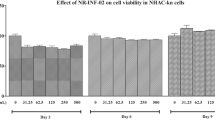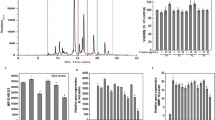Abstract
Phyllanthus amarus Schum. & Thonn. (P. amarus) has been reported to exhibit anti-inflammation and antiarthritis properties leading to our interest to examine its beneficial effect in osteoarthritis. Thus, this study aimed to explore the chondroprotective potential of P. amarus extract (PAE) and its major compounds, phyllanthin and hypophyllanthin, in a cartilage explant model. Various concentrations of P. amarus extract, phyllanthin and hypophyllanthin, were treated on porcine articular cartilage explants induced with 25 ng/ml of interleukin-1 beta (IL-1β). After 4 days of incubation, the culture medium was measured for the release of sulfate glycosaminoglycans (s-GAGs) and matrix metalloproteinase-2 (MMP-2) activity by DMMB binding assay and zymography, respectively. The explant tissues were analyzed for the remaining of uronic acid content by colorimetric assay and stained with safranin-O for investigation of proteoglycan content. Cell viability of this model was evaluated by lactate dehydrogenase (LDH) assay. Chondroprotective potential of PAE and the major components against IL-1β-induced cartilage explant degradation were revealed by the decreased s-GAGs level and MMP-2 activity in culture medium consistent with an increase in uronic acid and proteoglycan contents in the explants when compared to the IL-1β treatment. These results agreed with those of diacerein and sesamin which used as positive controls. In addition, better chondroprotective activities of P. amarus crude extracts than those of the purified components were disclosed in this study. Hence, this is a pioneering study presenting the chondroprotective potential of PAE which may augment its application for therapeutic use as an antiarthritic agent.





Similar content being viewed by others
References
Abramson SB, Attur M (2009) Developments in the scientific understanding of osteoarthritis. Arthritis Res Ther 11:227
Alam MR, Ji JR, Kim MS, Kim NS (2011) Biomarkers for identifying the early phases of osteoarthritis secondary to medial patellar luxation in dogs. J Vet Sci 12:273–280
Amin ZA, Alshawsh MA, Kassim M, Ali HM, Abdulla MA (2013) Gene expression profiling reveals underlying molecular mechanism of hepatoprotective effect of Phyllanthus niruri on thioacetamide-induced hepatotoxicity in Sprague Dawley rats. BMC Complement Altern Med 13:160
Bjarnason I, Hayllar J, MacPherson AJ, Russell AS (1993) Side effects of nonsteroidal anti-inflammatory drugs on the small and large intestine in humans. Gastroenterology 104:1832–1847
Carvalho RS, Yen EHK, Suga DM (1995) Glycosaminoglycan synthesis in the rat articular disk in response to mechanical stress. Am J Orthod Dentofacial Orthop 107:401–410
Cesaretti M, Luppi E, Maccari F, Volpi N (2003) A 96-well assay for uronic acid carbazole reaction. Carbohydr Polym 54:59–61
Chaiwongsa R, Ongchai S, Tangyuenyong S, Kongtawelert P, Panthong A, Reutrakul R (2012) Chondroprotective potential of bioactive compounds of Zingiber cassumunar Roxb. against cytokine-induced cartilage degradation in explant culture. J Med Plants Res 6:5204–5213
Chiang LC, Ng LT, Cheng PW, Chiang W, Lin CC (2005) Antiviral activities of extracts and selected pure constituents of Ocimum basilicum. Clin Exp Pharmacol Physiol 32:811–816
Chirdchupunseree H, Pramyothin P (2010) Protective activity of phyllanthin in ethanol-treated primary culture of rat hepatocytes. J Ethnopharmacol 128:172–176
Chotjumlong P, Khongkhunthian S, Ongchai S, Reutrakul V, Krisanaprakornkit S (2010) Human β-defensin-3 up-regulates cyclooxygenase-2 expression and prostaglandin E2 synthesis in human gingival fibroblasts. J Periodontal Res 45:464–470
Crick F (1970) Central dogma of molecular biology. Nature 227:561–563
Del Carlo M Jr, Loeser RF (2008) Cell death in osteoarthritis. Curr Rheumatol Rep 10:37–42
Engel LW, Straus SE (2002) Development of therapeutics: opportunities within complementary and alternative medicine. Nat Rev Drug Discov 1:229–237
Fang SH, Rao YK, Tzeng YM (2008) Anti-oxidant and inflammatory mediator's growth inhibitory effects of compounds isolated from Phyllanthus urinaria. J Ethnopharmacol 116:333–340
Farndale RW, Sayers CA, Barrett AJ (1982) A direct spectrophotometric microassay for sulfated glycosaminoglycans in cartilage cultures. Connect Tissue Res 9:247–248
Funk JL, Frye JB, Oyarzo JN, Timmermann BN (2009) Comparative effects of two gingerol-containing Zingiber officinale extracts on experimental rheumatoid arthritis. J Nat Prod 72:403–407
Galasso O, Familiari F, Gori MD, Gasparini G (2012) Recent findings on the role of gelatinases (matrix metalloproteinase-2 and −9) in osteoarthritis. Adv Orthop 2012:834208
Goldring MB (2000) The role of the chondrocyte in osteoarthritis. Arthritis Rheum 43:1916–1926
Goldring MB, Otero M (2011) Inflammation in osteoarthritis. Curr Opin Rheumatol 23:471–478
Hashimoto M, Nakasa T, Hikata T, Asahara H (2008) Molecular network of cartilage homeostasis and osteoarthritis. Med Res Rev 28:464–481
Hoppmann RA, Peden JG, Ober SK (1991) Central nervous system side effects of nonsteroidal anti-inflammatory drugs: aseptic meningitis, psychosis, and cognitive dysfunction. Arch Intern Med 151:1309–1313
Huh JE, Baek YH, Kim YJ, Lee JD, Choi DY, Park DS (2009) Protective effects of butanol fraction from Betula platyphyla var. japonica on cartilage alterations in a rabbit collagenase-induced osteoarthritis. J Ethnopharmacol 123:515–521
Jeng KC, Hou RC, Wang JC, Ping LI (2005) Sesamin inhibits lipopolysaccharide-induced cytokine production by suppression of p38 mitogen-activated protein kinase and nuclear factor-kappaB. Immunol Lett 97:101–106
Kandhare AD, Ghosh P, Ghule AE, Zambare GN, Bodhankar SL (2013) Protective effect of Phyllanthus amarus by modulation of endogenous biomarkers and DNA damage in acetic acid induced ulcerative colitis: role of phyllanthin and hypophyllanthin. Apollo Med 10:87–97
Karuna R, Reddy SS, Baskar R, Saralakumari D (2009) Antioxidant potential of aqueous extract of Phyllanthus amarus in rats. Indian J Pharmacol 41:64–67
Kassuya CAL, Leite DFP, Melo LV, Rehder VLG, Calixto JB (2005) Anti-inflammatory properties of extracts, fractions and lignans isolated from Phyllanthus amarus. Planta Med 71:721–726
Kiemer AK, Hartung T, Huber C, Vollmar AM (2003) Phyllanthus amarus has anti-inflammatory potential by inhibition of iNOS, COX-2, and cytokines via the NF-κB pathway. J Hepatol 38:289–297
Krithika R, Jyothilakshmi V, Verma RJ (2014) Phyllanthin inhibits CCl4-mediated oxidative stress and hepatic fibrosis by down-regulating TNF-α/NF-kappaB and pro-fibrotic factor TGF-beta1 mediated inflammatory signaling. Toxicol Ind Health. (in press). doi: 10.1177/0748233714532996
Kuptniratsaikul V, Thanakhumtorn S, Chinswangwatanakul P, Wattanamongkonsil L, Thamlikitkul V (2009) Efficacy and safety of Curcuma domestica extracts in patients with knee osteoarthritis. J Altern Complement Med 15:891–897
Loeser RF, Goldring SR, Scanzello CR, Goldring MB (2012) Osteoarthritis: a disease of the joint as an organ. Arthritis Rheum 64:1697–1170
Lotz M, Hashimoto S, Kuhn K (1999) Mechanisms of chondrocyte apoptosis. Osteoarthritis Cartil 7:389–391
Lu KH, Yang HW, Su CW, Lue KH, Yang SF, Hsieh YS (2013) Phyllanthus urinaria suppresses human osteosarcoma cell invasion and migration by transcriptionally inhibiting u-PA via ERK and Akt signaling pathways. Food Chem Toxicol 52:193–199
Mali SM, Sinnathambi A, Kapase CU, Bodhankar SL, Mahadik KR (2011) Anti-arthritic activity of standardised extract of Phyllanthus amarus in Freund’s complete adjuvant induced arthritis. Biomed Aging Pathol 1:185–190
Martel-Pelletier J, Pelletier JP (2010) Effects of diacerein at the molecular level in the osteoarthritis disease process. Ther Adv Musculoskelet Dis 2:95–104
Mueller MB, Tuan RS (2011) Anabolic/Catabolic balance in pathogenesis of osteoarthritis: identifying molecular targets. PM&R 3:S3–S11
Ong-Chai S, Chaiwongsa R, Viriyakhasem N, Pompimon W, Tangyuenyong S (2008) Effect of active compounds from Andrographis paniculata (nees) on protection of equine articular cartilage degradation in vitro. KKU Vet J 18:81–96
Parhamifar L, Andersen H, Moghimi SM (2013) Lactate dehydrogenase assay for assessment of polycation cytotoxicity. Methods Mol Biol 948:13–22
Patel JR, Tripathi P, Sharma V, Chauhan NS, Dixit VK (2011) Phyllanthus amarus :Ethnomedicinal uses, phytochemistry and pharmacology :A review. J Ethnopharmacol 138:286–313
Phitak T, Pothacharoen P, Settakorn J, Poompimol W, Caterson B, Kongtawelert P (2012) Chondroprotective and anti-inflammatory effects of sesamin. Phytochemistry 80:77–88
Pradit W, Nganvongpanit K, Siengdee P, Buddhachat K, Osathanunkul M, Chomdej S (2012) In vitro effects of polysaccharide gel extracted from durian rinds (Durio Zibethinus L.) on the enzymatic activities of MMP-2, MMP-3 and MMP-9 in canine chondrocyte culture. IJBBB 2:151–154
Tang YQ, Jaganath I, Manikam R, Sekaran SD (2013) Phyllanthus suppresses prostate cancer cell, PC-3, proliferation and induces apoptosis through multiple signalling pathways (MAPKs, PI3K/Akt, NFB, and Hypoxia). Evid Based Complement Alternat Med 2013:13
Tripathi AK, Verma RK, Gupta AK, Gupta MM, Khanuja SPS (2006) Quantitative determination of phyllanthin and hypophyllanthin in Phyllanthus species by high-performance thin layer chromatography. Phytochem Analysis 17:394–397
Troeberg L, Nagase H (2012) Proteases involved in cartilage matrix degradation in osteoarthritis. Biochim Biophys Acta 1824:133–145
Weis M, Heeschen C, Glassford AJ, Cooke JP (2002) Statins have biphasic effects on angiogenesis. Circulation 105:739–745
Woolf AD (2012) Influential global alliance calls on governments and the World Health Organisation to prioritise musculoskeletal health following findings of Global Burden of Disease Study 2010. Truro, UK. http://www.cmcc.ca/document.doc?id=1459. Cited 10 Aug 2014
Yahayo W, Supabphol A, Supabphol R (2013) Suppression of human fibrosarcoma cell metastasis by Phyllanthus emblica extract in vitro. Asian Pac J Cancer Prev 14:6863–6867
Zamli Z, Adams MA, Tarlton JF, Sharif M (2013) Increased chondrocyte apoptosis is associated with progression of osteoarthritis in spontaneous Guinea pig models of the disease. Int J Mol Sci 14:17729–17743
Zrimšek P, Kos VK, Mrkun J, Kosec M (2007) Diagnostic value of MMP-2 and MMP-9 in synovial fluid for identifying osteoarthritis in the distal interphalangeal joint in horses. Acta Veterinaria Brno 76:87–95
Acknowledgments
This work was supported in part by the National Research Council of Thailand (Government Budgeting via Chiang Mai University; 2015) and Thailand Excellence Center for Tissue Engineering and Stem Cells, Faculty of Medicine, Chiang Mai University, Thailand. We also thank to the National Research University Project under Thailand’s Office of the Higher Education Commission. The authors gratefully acknowledge the assistance of Assoc. Prof. Dr. Ampai Panthong in editing the manuscript.
Author information
Authors and Affiliations
Corresponding author
Additional information
Editor: T. Okamoto
Waranee Pradit and Siriwadee Chomdej contributed equally to this work
Rights and permissions
About this article
Cite this article
Pradit, W., Chomdej, S., Nganvongpanit, K. et al. Chondroprotective potential of Phyllanthus amarus Schum. & Thonn. in experimentally induced cartilage degradation in the explants culture model. In Vitro Cell.Dev.Biol.-Animal 51, 336–344 (2015). https://doi.org/10.1007/s11626-014-9846-y
Received:
Accepted:
Published:
Issue Date:
DOI: https://doi.org/10.1007/s11626-014-9846-y




